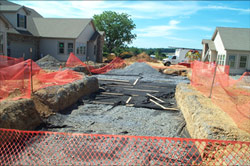
There's no doubt about it: stormwater management in Pennsylvania is a multi-layered, multi-jurisdictional, ever-changing quagmire of rules, regulations, and requirements.
SWM Regs

The National Perspective…
In 1990, updates to federal Clean Water Act regulations established the National Pollutant Discharge Elimination System (NPDES), requiring large construction sites, certain industrial facilities, and municipalities with populations of 100,000 or more to obtain NPDES (Phase I) permits and develop stormwater management plans.
In 1999, NPDES Phase II was signed into law to build on the initial program. While Phase I applied to construction sites affecting 5 acres or more, Phase II required all individual land development projects that disturb one acre or more to obtain permits. Phase II also required small municipalities to obtain permits for their stormwater discharges. Whether small or large construction site, industrial facility, or municipal separate storm sewer system (MS4), each facility must now obtain a permit and implement and enforce a stormwater management program.
…And How it's Applied in PA
Though the federal Environmental Protection Agency (EPA) manages the permitting process in some states, in Pennsylvania, the PA DEP administers the program and establishes permits for MS4s, industrial sites, and any construction activities which disturb more than one acre of land. This might sound straightforward enough, but there are additional layers, new programs, and evolving permit requirements to consider—all of which can make coordination and management of stormwater programs pretty complex.
Adding to the mix is Pennsylvania's unique system of "power sharing" amongst different levels of government, as laid out in the Pennsylvania Storm Water Management Act of 1978 (more commonly known as Act 167). The Act requires counties to create watershed-level stormwater management plans, and individual municipalities to adopt ordinances to implement the plans.
Key "moving targets" to keep an eye on include:
- EPA’s National Rulemaking process;
- TMDLs, or "total daily maximum load" (especially important is the “pollution diet” for the Chesapeake Bay and PA’s Watershed Implementation Plan (WIP), which is DEP’s proposal for our role in bringing the Bay back to health); and
- Changes to PA's Chapter 102 requirements and MS4 Permits.
Related News from our Blog
Federal Requirements
Since 1972, the federal Clean Water Act has prohibited the discharge of any pollutant to waters of the United States unless authorized by a National Pollutant Discharge Elimination System (NPDES) permit. The initial NPDES program regulated point source discharges; in 1990, NPDES Phase I was established to manage stormwater pollution from industrial and construction sites, as well as urban areas with populations greater than 100,000. In 1999, EPA adopted NPDES Phase II regulations to deal with address stormwater discharges from sites that were not covered under Phase I.
Phase I of NPDES applies to:
- Construction sites disturbing greater than five acres
- Companies that fall in one of the eleven categories of industrial sites
- Large and medium municipalities (MS4’s) with populations of 100,000 or greater
Phase II of NPDES applies to:
- Construction sites disturbing one to five-acres
- Municipalities in urbanized areas not covered by Phase I, otherwise known as small MS4s.
State and municipal stormwater requirements are based upon these federal regulations, and incorporate additional provisions to address the specific needs and conditions of individual watersheds.

